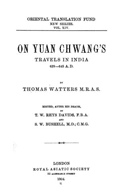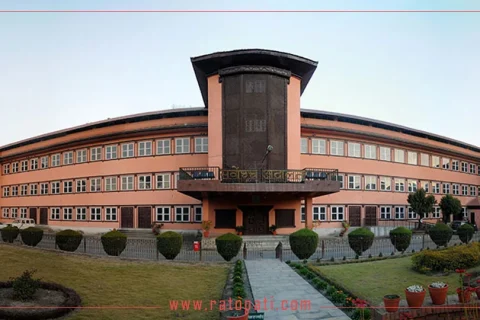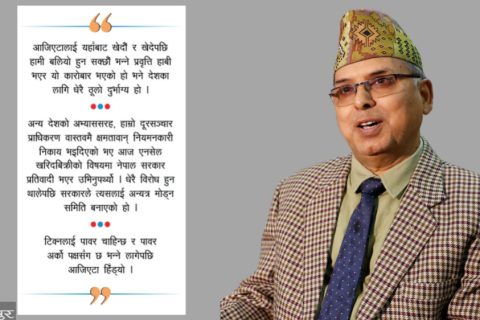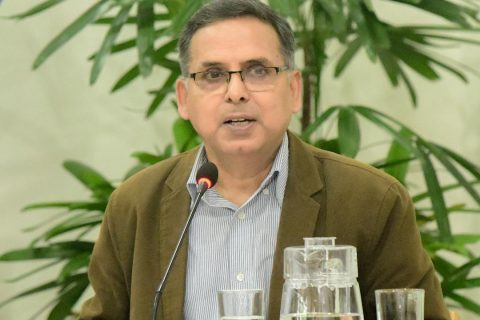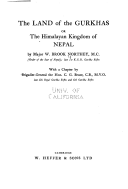
William Brook Northey, The Land of the Gurkhas or The Himalayan Kingdom of Nepal [Cambridge: W. Heffer & Sons Ltd, 1937]
William Brook Northey’s The Land of the Gurkhas or The Himalayan Kingdom of Nepal [Cambridge: W. Heffer & Sons Ltd, 1937] was published 14 years before the political changeover of 1950-51. The book begins with a general survey of Nepal by Brigadier General C. G. Bruce.
Like many other books which were published on Nepal before, Northey’s book starts with the introduction of the Nepalese land, the early history of Nepal, the rise of the Gurkhas and Prime Minister Jung Bahadur, who emerged following Anglo-Nepal War, and the turbulent years that followed. With this background, Northey generalizes the Gurkhas as they are, their customs and characteristics, and sports and diversions. Kathmandu, the capital of the Gurkhas, has been described well along with the temples and shrines, followed by the town of Patan, Bhatgaon and Nawakot. The central part of Nepal finds special mention in the book. Both the eastern and western borders of the country are discussed along with Darjeeling, which was lost to Britain after the Treaty of Sugauli, and its surroundings.
Unlike many of his predecessors, William Brook Northey also writes about the Western border of Nepal and the society around there. He points it out very categorically that the Nepalese people inhabiting the extreme western districts of Nepal – Doti, Baitadi, Jumla, Bajhang, and so on “are often not classified as Gurkhas.” There is a remarkable difference between the appearance of these people, he says, and those in the eastern part of Nepal. Be they from the Chetri tribe, the Dotials or Bajhangis, they “looked much rougher and more uncouth than any Gurkhas with whom I had ever been brought into contact before, giving the impression that existence in these extreme western districts was a good deal harder than that known elsewhere.”
Northey notes that the communities in the far Western Nepal bear little resemblance to their sturdier neighbours in Central and Eastern Nepal. Rather they look similar to the Kumaonis people inhabiting the hills west of the Mahakali river. Their customs, appearance, and even language look similar. The striking difference that Northey finds is that “just as the farther one goes eastwards in Nepal the races become more and more influenced by Mongolian ideas in the matter of customs and religion, so as one progresses in a westerly direction they become more and more disposed to Hinduism, until they eventually lose every trace of the Mongolian influence, and become as Hindu in culture as the Aryan speaking tribes that are found in the adjacent districts of British India.”
Northey also tries to explain who the Gurkhas are. The communities he adds in this group are the Thakuri, Chetri or Khas, Newars, Gurung, Magar, Rai, Limbu, Sunwar and Tamang, and so on. He also includes Brahmins in the group. He thinks that Thakuris, even though they owe Rajput ancestry, sometime resemble Chetris in certain cases. A majority of them are, however, hardly distinguishable from the Mongolian-looking Magars or Gurungs. He does not explain what the reasons must be behind these similarities. “Nonetheless, speaking generally, the Gurkhas as a race are decidedly Mongolian in appearance, possessing the high cheek-bones and almond-shaped eyes peculiar to that race.”
There are several other interesting insights in Northey’s about the Gurkha people. He writes about homespun Nepalese cap, chaubandi-surubal,and Khukuri that Gurkhas wear. He notes that “to be tall in Nepal brings no special admiration.” Nepalese are of small height for sure. Strangely, however, he quips that there is one regiment in the Nepalese army, the rifle regiment, in which the men are all six feet and more. Similarly, he finds that “a well-bred Gurkha is almost invariably fair skinned.” There are very few dark-complexioned Gurkhas, who will, in such case, be invariably nick-named as ‘Blackie.’ Adding further on the peculiarities, he refers to tribal regiments of the soldiers in Nepal. Examples given are that of the same tribe like Kali Bahadur Regiment composed solely of Gurung and the Purano Gorakh, of men of the Magar tribe.
Northey makes a point that the shoes that Nepalis wear are gradually being discarded in favour of European shoes in recent years. He also points out that Nepalese have started wearing a tweed coat of European pattern over the chaubandi that men wear with surubal. As far as money is concerned, Gurkhas love to earn and spend and might therefore be described, according to Northey, as Anglo-Saxon in their orientation. A Gurkha regards money “as something that should be spent. In this he differs greatly from the Indian of the plains, who loves to hoard his pice [paisa] as carefully as a Frenchman does his sous.” The author also gives some space to Gurkha songs. He thinks many of them are very primitive. But there are certainly some songs full of emotions. The example given is –
“In the heavens above are more than nine lakhs of stars.
I cannot count them.
Thus the words of my heart surge up into my mouth.
But I cannot utter them.”
Comparing the caste system in Nepal with that in the Darjeeling hills, Northey writes of its more liberal nature in Darjeeling. “Men of the highest caste are to be found in quite lowly occupations or doing work that they could never perform in their own country. Thus the syce(groom) of the pony that you hire on the Mall may as likely as not be a Chetri or even a Brahman, while the fact that a man of good caste marries a woman of low caste, or vice versa, seems no matter very little if at all here.”
There is some reference about Nepal’s urban centres as well. “Outside the valley there are but few towns in Nepal that can be called important centres. Some like Ilam, Dhankuta, Jumla and Salyana, enjoy a certain amount of local prestige as chief towns and civil headquarters of districts, as others, like Silgarhi, Daelekh and Baitadi, do in virtue of their being military stations, while the shrines at Ririand Muktinath attract large numbers of pilgrims from India and Tibet; but that is all that can be said. In fact, of the provincial towns, perhaps only Butwal, Palpa, Tansing and Pokhara can with any justice be called important.”
Referring to Singh Durbar, or the home of the Prime Minister, Northey says “there is nothing of Nepalese architecture in this imposing building.” There is an interesting revelation that “of the roads in the hills, the greatest and most important is the one which traverses the entire length of the country from east to west leading from Darjeeling to Pithoragarh in Kumaon, a distance of more than five hundred miles.” There must be many men of letters in Nepal even now who may not have ever read or heard of this road, which does not even exist in the form of a remnant.
Northey mentions that while much of Terai is still very unhealthy during certain times of the year, “the Nepalese government has in recent years made great efforts to make at any rate certain parts of it more habitable, particularly in the Morang, where large stretches have been cleared and made suitable for human habitation.” In the town of Batauli [Butwal], which he visited in 1920, unlike Kassauli, the far side of the Tindo Khola, he also observes some dark-skinned Biharis and Marwaris.
The author had almost two decades of experience in a Gurkha regiment. He served Nepalese Escort in Kathmandu not only as a trainer, but also worked with the Nepalese contingent on the Indian frontier during the first World War, also serving thereafter as Gurkha recruitment officer for five years in Nepal. He was allowed by Prime Minister Chandra Shamsher to go around some parts of Nepal and have some first-hand experience in understanding this country. His insights on Nepal were also influenced by the authors who wrote of Nepal before him, like Sylvain Levy, Perceval Landon, and Percy Brown.
This is not William Brook Northey’s sole book on Nepal. He also co-authored another book on the Gurkhas, their manners, customs, and their country. This 1928 book deals with the people and their language, religion and festivals, government and administration, and Nepal’s war effort, to mention a few. There is also a chapter in the book on the slavery and the labour problem.
The present book contains a good bibliography and index. It also has many important illustration attracting attention of any reader. The author points out the preface to the book that the map of Nepal that appears here is drawn from the most recent survey of Nepal. This is an interesting old book giving new insights. As Samuel Bulter, an iconoclastic victorian-era English author, remarked, “the oldest books are still only just out to those who have not read them.”



